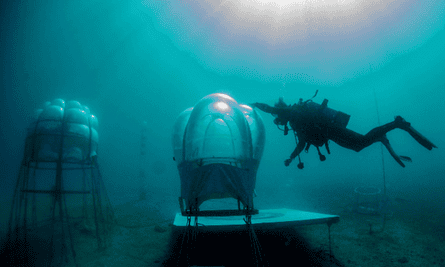Beneath the blue waters 100m off the coast of Noli in northwest Italy lies a cluster of balloon-like pods pegged to the seabed by ropes half a dozen or so metres long. Inside a range of produce is being grown, including red cabbage, lettuce, beans, basil and strawberries.
It may sound like something you’d find in a science fiction novel, but this is the work of Ocean Reef Group. With the help of agricultural experts, the Genova-based scuba diving company is applying its knowledge and technology to finding new ways to produce food.
The research project, known as Nemo’s Garden, began in 2012 and currently consists of seven pods – biospheres – each of which can hold around 8-10 trays or 22 plant pots. Having improved the design of the pods over time following episodes of rot and flooding, the company is ready to scale up its testing with the ultimate aim of commercialising its operations. The company has a local government permit to operate for five months of the year (May to September) and the pod structure has been patented. The project is currently seeking financial assistance through a crowdfunding campaign which ends this week.
Inside the pods
The company uses a version of hydroponics, creating fresh water through desalination. Seawater within the structures evaporates, drops condense on the roof and then drip back down as fresh water to feed the herbs and vegetables.
Unlike underground hydroponic systems and greenhouses, which rely on various heating and cooling systems and LED lights to regulate the temperature, submersion in seawater offers a stable temperature while avoiding exposure to extreme weather conditions on land. When it comes to sunlight, studies have shown that a majority of plants – although not seaweed – are dependent on the red spectrum in light for physiological development; the red can filter out at depths of around five to 15m. To address this, the pods are submerged five to eight metres below the surface; they could potentially go deeper but more data is needed to work out the viability of this.
Jon Old is co-founder of The Wasabi Company. The horseradish-like vegetable is regarded as one of the most intensive crops to grow. It involves a lot of watering and is vulnerable to high temperatures and direct sunlight, so could potentially be ideal for underwater farming. Old is excited by the potential of the Nemo Project model: “certain aspects are very appealing, like the sealed environment, no pests to wander in, no disease spores to blow in on the wind, and no slugs. If we assume the underwater [farm] is structurally sound, I think it would be fantastic. It’d be like working in a huge, dry aquarium all day.”
Meeting future food demands
Qualified divers are required to maintain and operate the pods. Luca Gamberini, whose family has been running the Ocean Reef Group for six decades, acknowledges this is a sticking point, but firmly believes underwater farming can be more than just a plaything for growing high-value, niche crops.

Although the cultivation of Nemo’s Garden is yet to reach commercial scale, the aim of the project is to see whether that is a viable prospect and to plant more varieties of crops in the process, something that Gamberini believes is technically possible. Tests carried out by Ocean Reef Group suggest that crops underwater grow faster than their counterparts, according to the company.
Ocean Reef Group has received interest from businesses and organisations, but has so far decided against selling the concept. Gamberini believes its place in the food system could be dynamic, from small producers to NGOs working on nutrition projects in developing countries.
“That [meeting future food demands] is the aim, and it could be a sustainable way of agriculture,” he says. “Not just local businesses, but for large parts of the world. Starting from Middle Eastern and tropical countries such as the Maldives, where there is not much [suitable] soil or fresh water ... [to] southern California, which is experiencing droughts.”
Not everyone is convinced. Rachel Kerr is a relief worker who has worked on nutrition projects in sub-Saharan Africa. “My concern would be whether a set-up like this would disrupt the local food infrastructure. Coastal communities often rely on fish not just as food but as a source of income,” she says. “It would need to respect local customs and be mindful of the environment [the ocean].”
Gamberini acknowledges that some people may not buy into the idea of underwater farming, but believes it has the potential to work harmoniously with other food production methods. Despite his optimism, however, he remains cautious about its long-term potential.
“We know that we can grow plants underwater, we know they grow faster. We now need to finalise our research ... hopefully by the end of the year, or next,” he says. “Worst case scenario, if we discover Nemo’s Garden isn’t feasible in terms of size, logistics and economics, is that it’ll be a credible eco-tourism resource, as scuba diving sites for islands and places with warm waters.”

Comments (…)
Sign in or create your Guardian account to join the discussion